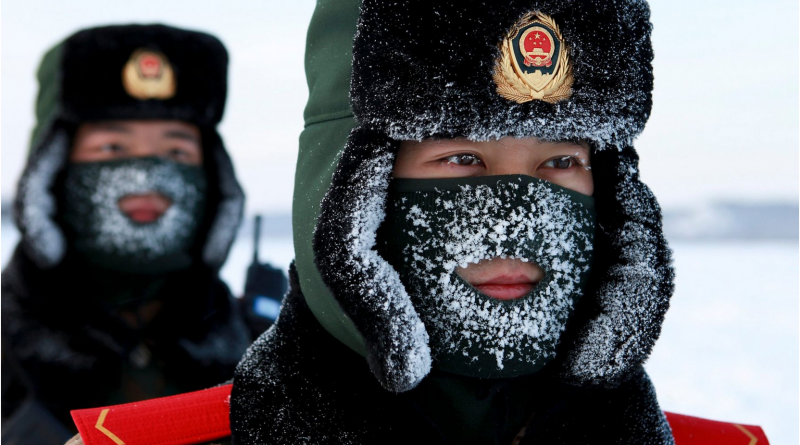China and Russia Want to Control the ‘World Island’
By Adm. James Stavridis, dean emeritus of the Fletcher School of Law and Diplomacy at Tufts University
In the classic 1980s comedy “Ghostbusters,” the heroes have one serious rule for using their powerful anti-ghost weapons, which emit long beams of specter-killing electrons: “Don’t cross the streams.”As the U.S. and its allies watch the continuing rapprochement between Russia and China, they would do well to heed that advice: each rival is dangerous, but as they converge they become a true global threat.
One concrete indication of this growing risk is the escalating boldness of the Russian Navy, which has been confronting U.S. warships around the world. Most recently, and dangerously, was the near-collisionof the U.S. cruiser Chancellorsville and a Russian destroyer that made a reckless approach to within 100 feet in the western Pacific, waters that the Chinese are increasingly looking at as their own.
During the Cold War, for the most part, China and the Soviet Union kept a wary distance from each other. Over the past several years, however, under Presidents Xi Jinping and Vladimir Putin, they are drawing closer and closer. This coalescing, possibly resulting in a unified block that dominates the Eurasian continent, may be the most important geopolitical trend of the 21st century.
Last fall, Vostok 2018, the largest military exercise the world has seen since the end of the Cold War, was conducted on the Siberian border between Russia and China. Hundreds of thousands of Russian troops were joined by Chinese soldiers; photos show Russian and Chinese officers hugging each other. Joint Russian-Chinese naval exercises are occurring with increasing frequency – not just in the Pacific, but also in the Baltic Sea and the Arctic Ocean. Last week, Xi and Putin spent days together in Russia, proclaiming themselves “best friends.”Economic and diplomatic alignments mirror the military marriage unfolding before our eyes.
The pairing has a certain logic. China is rising as a global power and has a vast population, yet lacks many vital natural resources. Russia is failing economically and has a falling population, but is loaded with timber, water, minerals, gold, oil and natural gas. They share a long border. And both are resolutely authoritarian states with effectively single-party and single-person rule. Above all, they share an antipathy for the West in general – with its pesky efforts to spread democracy and support human rights – and disdain for the U.S. in particular. That is enough in common for an increasing level of cooperation, if not (yet) a formal military alliance.
Russia, however, ought to be careful what it wishes for. Chinese leaders look longingly at the boundless, unpopulated and resource-rich stretches of Siberia the way my dog looks at a ribeye steak. Putin, who is an annoyingly gifted tactician, may be making a strategic misstep by over-committing if he moves toward an official alliance. Over time, the dominant partner will certainly be Beijing, not Moscow. But for the moment, closer ties with China would provide Russia with new markets, political support and, above all, a counterbalance to the U.S.
As Europe continues to be pulled apart by various forces – Brexit to the north, Italian discontent with the European Union in the south, increasing authoritarianism in Poland and Hungary to the east – the continent’s ability to partner cohesively with the U.S. diminishes. Such weakness increases the value of the Chinese-Russian partnership in the eyes of the two participants. And the lure China’s “One Belt, One Road” initiative offers to smaller nations around the periphery of the Eurasian continent only increases if it includes engagement with Russia.
An immense geopolitical shift of this nature was foreseen more than a century ago by the British geographer and geopolitical analyst Halford MacKinder. In a remarkable paper delivered to the Royal Geographic society in 1904, he laid out the “Heartland Theory” – that any nation (or nations) which could dominate the “world island” (Eurasia and Africa) would ultimately dominate the world. Around the same time, a countervailing hypothesis was set out by the American naval officer and strategist Alfred Thayer Mahan, holding that the sea powers – the U.S., U.K., Australia and their allies – would be able to compete with that dominant Eurasian power. While neither theory neatly or completely describes the current world, the basic pattern will be the geopolitical leitmotif of the 21st century.
For now, this means the U.S. and its allies must pay attention to the growing cooperation between Russia and China; focus intelligence collection on understanding how far it is likely to go; do all they can to encourage a unified Europe; and strengthen the network of alliances, partnerships and friendships around the periphery of Asia.
Watch the video: Letting the Russia-China streams cross wouldn’t cause a ghostly apocalypse, but it would shift the entire balance of global diplomacy and security.
This article was republished from Bloomberg Opinion.

